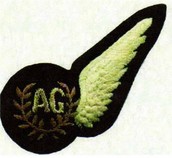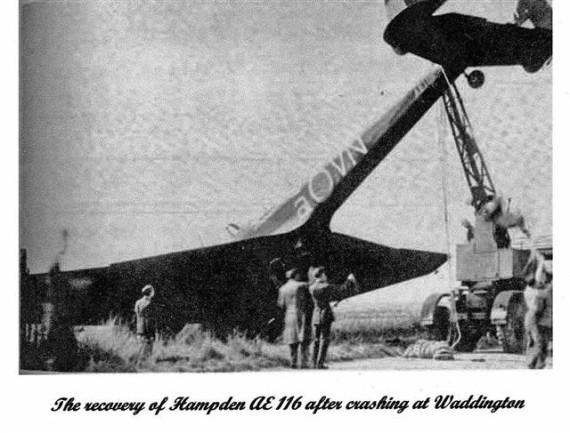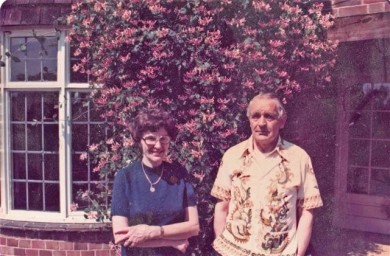Photos and information supplied by David Layne, son of F/O Layne.
F/O Walter H. Layne DFC served in the RAF during WW11. He completed a tour of operations with 50 squadron during which he survived a Hampden bomber crash landing. He then went on to serve in 97 squadron, during which his squadron was moved to 8 Group Pathfinder Force. On his 64th operation, which completed his second tour, his aircraft was shot down. He then became a German Prisoner Of War. During his captivity he was forced to take part in the infamous "Death March", during which many POWs froze to death. He certainly had a charmed life.
Both his Commission and D.F.C. were awarded whilst he was a POW.
This is his story.
Born December 1916 in Brigg Lincolnshire.
Educated Brigg Grammar School.
On Sunday September 3rd 1939 the Prime Minister of Great Britain, Neville Chamberlain stated in a radio broadcast, that a state of war now existed between Great Britain and Germany.
The following day Walley immediately volunteered for RAF Aircrew duty.
On April 9th 1940 he was enlisted in the RAF at No 2 Reception Centre, Cardington, Bedfordshire.
During initial training he underwent aptitude tests and was recommended for training as a wireless operator/air gunner.
On 17 June 1940 he moved to RAF Yatesbury, Air Operation Section No 2 Electrical and Wireless School for training as a Wireless Operator/Air Gunner.
On the twin engined Hampden bomber the crew members are listed in the following order, Pilot, Navigator, Wireless Operator/Gunner, and Rear Gunner.
lst operation. On July 1st 1941 Sgt Layne arrived at RAF Lindholme to take up Active duties with 50 Squadron.
Operation. July 6 1941 BREST (FRANCE)
Take off time 22.20 from Lindholme
Hampden 839. Crew, Pilot F/Lt Fox, P/O Helmore, Sgt Ballantyne, Sgt Layne.
One of a force of 88 Hampdens and 21 Wellingtons on his first operation Walter Layne's crew was detailed to bomb the Battleships Scharnhorst and Gneisenau then sheltering in Brest harbour. The route out was via Upper Heyford and Chesil Beach.
The crew was fortunate to follow an aircraft into the target area that was drawing considerable fire. Smoke screens hid the battleships but a good run over the target area was made at 14,500 feet. Over the target flak and tracer were very intense working in co-operation with searchlights.
The two 2,000 lbs. bombs were seen to burst on the estimated position of the warships from the docks which were clearly visible in the bright moonlight.
An aircraft at approximately 3,000 feet was seen to be shot down in flames to the west of the town. Later research has revealed this aircraft that crashed at Guilers, was 12 Squadron Wellington W 5360 piloted by S/L A.G.G.Baird and crew. There were no survivors.
Returned to base with a total of 6.00 hours operational flying.
3rd operation 12th July 1941 BREMEN (GERMANY)
Take off time 2215 from Lindholme.
Hampden 839. Crew F/Lt Fox. P/O Bartley, Sgt Ballantyne, Sgt Layne.
Along with 33 Hampdens and 28 Wellington from other squadrons, the crew were detailed to bomb the railway junction at Bremen, The route chosen, Skegness to the target was free of flak and searchlights. A small amount of accurate heavy flak was encountered over the target. Although there was a thick haze, tbe target was identified by the river. The bombs were released from 13,599 feet on three seperate runs, all failed to hit the target and fell into the town.
An unidentified aircraft fired cannon but was lost on evasive action taken. The aircraft landed at Conigsby with a total time of 6.35 hours, returning to Lindhol;me the following day.
Sadly two 50 Squadron aircraft failed to return.
..................................................
On July 19 1941 50 Squadron moved from Lindholme to Swinderby. The squadron departed Lindholme in formation. Shortly after take-off the airmen were horrified to see Hampden AD 897 roll over onto it's back and fly inverted for a few seconds before diving into the ground killing Sgt Bousfield and crew.
..................................................
The photograph below was taken at Skellingthorpe. Wally is under the right (aircraft's left) propeller hub.
2 September 1941. COPENHAGEN HARBOUR (DENMARK)
Hampden 251. Crew: Pilot P/O Carter, P/O Davidson,Sgt Layne, Sgt Gilmore.
The crew were one of 16 aircraft detailed to drop vegetables (mines) in the Daffodil (Copenhagen) area. Owing to adverse weather conditions and no pin point being obtained the mines were jettisoned at a fixed position as 57 degrees North, East.
Returning to base the fuel supply was running low and on reaching
Skegness after obtaining a fix and Q.D.M's (magnetic course) there was only 30 gallons left in the starboard tanks, with Waddington still 30 miles distant.
The intercom and TR9 (early radio transceiver) failed a few minutes later and Waddington could not be heard replying to transmissions.
On arrival at Waddington the starboard engine cut out and one circuit of the airfield was made. Mist prevented the aerodrome from being seen and the aircraft made a forced landing in a ploughed field going through a fence in the process. Fortunately without injury to the crew. It was later determined that the fuel gauges were inaccurate.
At this time, P/O Carter had a total of 140 flying hours, 46 of those being night and 39 hours on Hampdens. On this, operational flying time of 9.35 hours were logged by the crew.
Below:
June 1941. "The Parklands" public house, Boultham Park Road, Lincoln'
L to R. Wally Layne, "Woof" Welford, "Johnnie" Tytherleigh (with pipe) and F/Sgt.Stuart Melbourne Hobson.
"Woof" completed a tour with 50 sqdn. No further record.
Johnnie completed a tour with 50 sqdn. and then moved on to 617 sqdn.
He was S/L Maudsley's front gunner on the "Dams Raid"during which he lost his life.
Stuart Melbourne Hobson.
F/Sgt Hobson completed a tour with 50 sqdn. and then moved to 9 Sqdn as a F/O (Air gunner). He lost his life on 5th April 1943.
Below: In this painting of AE116 by Mark Postlethwaite Pilot P/O Carter has slid his canopy back; the Navigator P/O Davidson is in the nose and Sgt. Layne the Rear Gunner has opened his canopy. All are searching the mist covered Lincolnshire for Waddington airbase moments before running out of fuel and crashing.
This was an interesting night for 50 Squadron. In addition to Hampden AE 116 crashing at Waddington, Hampden AE 157 crashed at the same airfield after also returning from mining Copenhagen Harbour.
In addition to mining the waters of Copenhagen 50 Squadron also sent aircraft to Berlin. Three of these aircraft crashed on returning to England.
AE 305 piloted by F/S Titcombe crash landed in Norfolk and X 2919 with Sgt Mudd at the controls crash landed in Cambridgeshire between Wittering and Wansford. P/O Waddell and crew in Hampden AE 250 ran out of fuel trying to reach Cottesmore.
Both of the crashes at Waddington and those piloted by Titcombe, Mudd and Waddell were due to the aircraft running out of fuel after in excess of 9 hours in the air. There were only minor injuries to Mudd and another of his crew members.
In his career Sgt. Mudd was at the controls of 4 Hampdens that crashed. Apparently in addition to X 2919 Mudd was the pilot of AE229, L4120 and P4314 when they either crashed, or were lost.
On 15 Feb. 1942 (the day Singapore fell) Walter H. Layne married Joan Maunders of Grantham.
As the bride was about to enter Grantham Church 3 Hampden Bombers buzzed the Church. Joan was so excited that she threw her bouquet up in the air.
Actually the trio had buzzed every church in Grantham to make sure they found the correct one
36. March 24th 1942. L'ORIENT (FRANCE)
Take off time 1915 from Skellingthorpe.
Hampden 152. F/Sgt. Lord. Sgt. Miller, Sgt. Layner, Sgt Paul.
This aircraft was one of seventeen detailed to lay mines in the waters off L'Orient in the Artichoke area. On reaching the target area they made a timed run from L'Orient , skirting Ilr de Croix. Mines were seen to hit the water in the primary position. The sky was moonlit with no cloud but hazy. Landed at St. Eval after 5.50 hours of flight time. The crew returned to base the following day.
At that time during WW11 200 hours flying time represented a tour of operations.
With 200 hours flying time completed Wally took up a position in the 50 Squadron Conversion Unit.
His time was spent as a Wireless Operator on local training flights.carried out duties with the 50 Squadron Conversion Unit. In August '42' he made five flights (Lancasters and Manchesters) with "50 Conversion Flight" Swinderby I believe this unit then became 9 Conversion Flight at Waddington and he logged nine flights there, same aircraft as before. In October '42' he was with 1661 HCU and made two flights with an additional three in December of 1942. Two of those are logged as 'staff.
54 August 17th 1943. PEENEMUNDE (GERMANY) "Operation Hydra"
Take off time from Bourn 2110.
Lancaster ED 866 P Crew, F/O Fletcher, Sgt Nelson, F/Sgt. Dunn, Sgt. Beesley, F/Sgt. Layne, Sgt. Laing, Sgt. Page.
A mixed force of 596 heavy bombers, consisting of Lancasters, Halifaxes and Stirlings participated in this raid on Peenemunde, located on the Baltic coast. This was the first operation the R.A.F. used the Master Bomber (or Master of Ceremonies) technique to control the attack. 97 Squadron were to provide 20 Lancasters for this operation however 3 aircraft were unable to take off, and 1 returned early with an inaccurate compass and faulty navigational aids.
The Fletcher crew was detailed to attack the scientist quarters at Peenemunde Army Research Center that was at that time developing the long range V1 and V2 weapons programme. They carried 1 x 4,000 lb bomb, 5 x 500 lb bombs and 4 x 250 lb markers.
Peenemunde was attacked from 14,000 feet in bright moonlight with no clouds and good visibilty. The bomb load was dropped on a cluster of red T.I. markers, and the crew's bombs were seen to fall on a railway. A smoke screen prevented further observation of ground results. O the return journey the glow of fires was seen from 100 miles away. A flight time of 6.50 hours was recorded on reaching base.
64th Operation. September 23rd., 1943. MANNHEIM. (GERMANY)
Take off time from Bourn, 1913hrs.
Lancaster JA 708 P. Crew, F/O Fletcher, Sgt. Nelson. S/L Foster, Sgt Beesley, F/Sgt Layne, S/L McKinna, Sgt. Page.
628 aircraft departed England for this raid on Mannheim; 32 aircraft were lost to include the crew of Lancaster JA 708 P. At the time of its loss the aircraft had a total of 103 hours of flying time. Also lost from 97 Squadron were the crew of W/O Stevenson.
This crew were briefed to be one of 97 Squadron's 16 aircraft detailed to attack Mannheim. The crew's bomb load consisted of 1 x 4,000 lb. bomb, 5 x 1,000 lb. bombs and 4 x 250 ib. markers.
97 Squadron's Gunnery Officer S/L McKinna and the squadron's Navigational Officer S/L Foster joined the crew for this operation.
McKinna and Foster replaced Dunn and White who were tour expired as would the whole crew be at the conclusion of this operation.
On arrival at the target the crew found clear skies and good visibility. On the bombing run they were picked up by radar guided searchlights, they bombed at 2145 hours and Pilot Fletcher immediately put the aircraft through evasive manoeuvrers but was unable to lose the searchlights.
All searchlights then switched off simultaneously and two minutes after bombing they were shot down by a Messerschmitt 110 piloted by Ulrich Vof 3. /JG 300. Veh working in coordination with the searchlight crews had followed the aircraft down in its attempts to evade the searchlights.
The two gunners, Sgt. Page and S/L McKinna were killed in the attack. With the aircraft on fire 4 crew members (Fletcher, Nelson, Beesley and Layne) were able to evacuate the aircraft successfully and parachute to safety. S/L Foster's body was found in the forest the next morning beside his deployed parachute. A German autopsy revealed that he died from a fractured skull.
Shot down over Germany with no possible help from locals or the Resistance, Walter Layne headed West and evaded for 10 days committing "friendly burglaries" for food and clothing, he also liberated a coat from a scarecrow in order to cover up his battle dress.
He lived off the Land eating root crops, mainly turnips and was eventually stopped by an armed German soldier, just East of Nancy, France having covered 110 miles in his westward trek.. Asked for his identity by the German Wally pretended to be deaf and dumb but the soldier opened his coat and found his escape map.
Soon after capture due to his uncooperative nature and the fact that he was wearing civilian clothing when captured he was told "You are to be shot!" Fortunately this did not happen! He was transferred to Dulug Luft the initial P.O.W. interrogation center where he was subjected to various psychological mistreatments by his captors.
When in Dulug Luft he was interviewed by Raymond Hughes who was posing as a Red Cross official. Hughes was an R.A.F. crew member who was shot down on the Peenemunde raid and turned traitor.
From Dulug Luft he commenced a tour of German P.O.W. camps. Firstly he was sent to Stalag Luft 6 at Heydekrug. When he arrived at Heydekrug he was interviewed by the Senior British Officer who told him that his first duty was to try and escape, Wally replied, "It's taken me two years to get here, I'm staying!"
He was then sent to Stalag Luft 111 at Sagan. His stay at Sagan was short, just a month and then he was sent back to Stalag Luft 6 Heydekrug.
With the advance of the Russians Heydekrug was evacuated and the prisoners spent a few weeks at Thorn before again being evacuated due to the advance of Russian forces. From Thorn they moved to Stalag 357 at Falllingbostel.
In January 1945 Walter Layne was again transferred from Fallingbostel to Stalag Luft 111 at Sagan. His stay at Sagan was short, only 5 days. With the sound of Russian guns to the east, the Germans, in order not to let the prisoners fall into the Russian hands, evacuated the camp with three hours notice. In blizzard conditions and with temperatures of -25C (-13F) the prisoners endured a forced march that is known as the Winter or "Death" March.
The forced march came to an end after 6 days when the prisoners were loaded, standing room only, into cattle trucks that were labelled "Forty hommes, eight chevaux" (Forty men or eight horses) and transported to Marlag in Northern Germany.
More than 200 men died of exposure and typhoid and typhus that struck them via lice covered bodies and a few at the rear of the column were killed when they were strafed by R.A.F. fighters.
The prisoners existed in squalid conditions at Malag for about three months before going on another forced march, known as the "Spring March". They were eventually liberted May 2nd 1945, 10 miles S.W. of Lubeck.
.........................................................................................................................................
Editor's comments:
As former member of 50 Squadron it has been both a pleasure and an honour to record Flying Officer Walter Henry Layne's .story in my 50-61 Squadron Veterans Album. He showed great strength of character, bravery and dedication to duty throughout his WW11 traumatic experiences. Both his Commission and D.F.C. were awarded when he was a POW. It took the Germans until Jan 45 to recognize his Officer status. He remained in Stalag Luft 6 (an NCO camp) until January 45 when he was shipped to Stalag Luft 111 (an Officers camp).
How fortunate Great Britain was to have in their hour of need the likes of Wally to rely on.
H. James Flowers
This story is but a brief summary of an amazing man. A full story is available by following the link to "Wallys War"





















